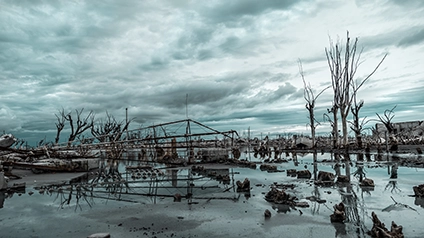The need for ALE may be the first thing that comes to mind after experiencing a catastrophic loss, such as the destruction brought on by Hurricane Ian. And, while you are probably in need of a cold beer after witnessing/dealing with the aftermath of Hurricane Ian, ALE has nothing to do with your preferred beer of choice. What we’re talking about is coverage for alternative/additional living costs following a covered insurance loss.
Unfortunately, Hurricane Ian has caused widespread destruction and it will take months, if not years, for Floridians to rebuild. Adding insult to injury, admitted and surplus insurance carriers that provide homeowners and/or flood coverage will often delay or improperly deny claims even when all the necessary paperwork has been filled out. Therefore, your displacement from your home may be exacerbated and the likelihood of a legal battle may be all too great.
During your displacement from your home, you may be eligible for monetary assistance under the ALE coverage of your insurance policy. ALE is generally a benefit found in your homeowners insurance policy which provides coverage when you are forced to leave your home either due to damage caused by a covered loss or the home becomes uninhabitable during reconstruction. Like with all aspects of your insurance claim, it is important to understand what ALE covers and how to present your ALE claim to your insurer.
Generally, ALE includes payment for necessities like transportation, food, and lodging incurred because of a covered insurance loss. If you have questions about additional living expenses coverage or how to submit a claim, please read on.
What Exactly Is Additional Living Expense Coverage?
Your home insurance policy should include coverage for ALE. Your policy’s “loss of use” section is typically where you will discover the amount of coverage you have available for ALE. And, if you must temporarily relocate, you won’t have to worry about how to pay for your new living arrangements thanks to ALE insurance.
ALE coverage will pay for things like the higher monthly food bill you incur because of having to eat out more frequently than usual; alternate lodging expenses until your house is habitable again, and:
The price of laundry service, if you can no longer wash your own laundry at home
Storage and rental fees for furniture
Costs associated with being relocated
Pet boarding
Temporary housing security deposit
Costlier gas to get to work due to temporary residence’s further distance from workplace
The price of a renter’s insurance policy to cover its occupants’ belongings
Costs associated with establishing utility service at a temporary residence
Relocation expenses from a temporary dwelling to a permanently repaired residence
Your insurer will compare the amount you are requesting for “extra living expense” to what it would normally cost you to live. Coverage for “extra living expense” is included in standard homeowner’s insurance policy and it’s meant to make up the difference between what you would have spent anyhow and what you’re now spending because you can’t stay in your home.
If your home is damaged or valuables are destroyed, such costs will not be covered by ALE coverage. You will need to file a claim with your homeowner’s insurance for those things instead. if you are having trouble getting reimbursement from your insurance carrier for these costs, contact a Hurricane Ian insurance lawyer for assistance.
Costs Accumulated While Dining Out
You should verify with your insurance adjuster what they consider to be an acceptable restaurant spend, as this is a regular component of ALE claims. You should also learn the procedure for how you will be reimbursed to make sure that you get your money back timely.
Obviously, an insurance carrier will not cover lavish meals out at restaurants. They will consider a standard ration of food that they have determined to be sufficient for your needs and they will contend that everything above that is entirely at your own expense.
In the same way, same considerations are applied when shopping for food. If you are staying in temporary housing that has a kitchen, your weekly or monthly expenses should not be more than what they were before the crisis.
Emergency Evacuation Coverage Under ALE
Additional living expense coverage may be available if your home is undamaged, but your town is under a mandatory evacuation order. For instance, if a hurricane is headed straight for your area and everyone must evacuate, you may be eligible for ALE coverage for the time you are away from home. But, keep in mind that your ALE coverage will not pay for lodging costs past the mandatory evacuation date if your home sustains no damage.
ALE and Flood
If your home is damaged by flood waters only, you are likely not entitled to ALE coverage as most Flood policies do not provide coverage for ALE. However, if your home sustains water damage from a hurricane, you should examine your homeowners’ policy to assess whether you are eligible for ALE. If you are having trouble assessing your entitlement to ALE, contact a Hurricane Ian insurance lawyer for assistance.
In Florida, flood insurance is not mandated by law. To get a mortgage, however, flood insurance may be required for people who live in locations with a high-risk of flooding. But, even if you do not live in a high-risk location, a flood insurance policy may be worthwhile to have even if it does not likely provide coverage for ALE. This is simply because there can sometimes be a clear difference between damage caused by flood and damage caused by a hurricane (even if a hurricane was the genesis of the flood water). If only flood water causes damage, then a homeowners’ policy will not likely provide coverage for flood water as flood damage is generally specifically excluded. Likewise, a flood policy that only covers flood damage will not cover damage from a hurricane (wind damage and ensuing water damage). This can, of course, create a gap in coverage where you might not have ALE available to you even though your home is unlivable.
Guidelines for Making a Claim for Cost-of-Living Increase
Only after a disaster (fire, hurricane, tornado etc.) does it become possible to file an ALE claim. Do not assume that you will obtain ALE compensation just because your home was damaged by a natural disaster. Call your insurance carrier as soon as possible to report the loss and to let it know if the damage renders your home uninhabitable. As a pro tip, don’t forget to log the time, duration, parties involved, and content of your phone calls.
Your insurance carrier’s adjuster will help you submit your claim and they can help you figure out what your options are and perhaps point you in the direction of temporary lodging. But, consider hiring a qualified Public Adjuster. He/she can relieve you of a lot of stress during the claims process. If you are not acquainted with a Public Adjuster, we know some great Public Adjusters located in different parts of the State who can assist you in filing and negotiating your claim. Remember, an insurance adjuster’s loyalty lies with the insurance company he represents, while a Public Adjuster is on your side.
Notably, each insurance carrier has its own standards for what constitutes an uninhabitable dwelling and ordinarily, the ALE coverage and expense must be authorized by them before payment is made. The length of time that you will receive ALE payments while your house is being repaired is something you should verify with your insurance adjuster.
Remember, the limitations of your ALE coverage will be determined by the coverage that you selected when you purchased your homeowners’ policy. ALE coverage limits generally are:
Approximately 30% of the dwelling limit amount for a typical homeowners’ insurance policy
Approximately 50% of the personal property or contents coverage on condominium policies
Approximately 30% of the personal property or contents coverage on a tenant policy
The Declarations Page of your homeowners’ insurance policy is where you’ll find the specifics of your coverage.
Get the Full Amount of Your Additional Living Expenses
To obtain the maximum payment of ALE you should keep all your receipts and submit them to your insurance provider. As proof that these costs are more than they would have been without the home’s loss of use, you must provide documentation showing how much higher they are. Show the insurer your regular bills and use them as a reference when discussing the magnitude of the price hike you’ve experienced. And, of course, try to get any authorization for out-of-the-ordinary costs in writing to avoid any potential disagreements.
If You Experience Difficulty Getting Your Insurance Claim Paid
If you’re experiencing problems filing, submitting, or collecting on a claim for hurricane-related property damage or securing coverage for additional living expenses, call The Farber Law Firm at 833-INS-LOSS or fill out a contact form at www.thehurricanelawyer.com. We offer a no-cost assessment of your case and know how to properly handle insurance claims after natural disasters like Hurricane Ian.




